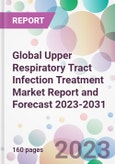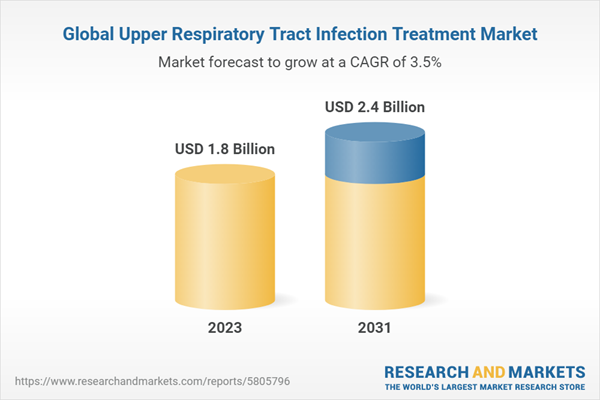The global upper respiratory tract infection treatment market was valued at USD 1.8 billion in 2022, driven by the increasing prevalence of upper respiratory tract infection across the globe. The market size is anticipated to grow at a CAGR of 3.5% during the forecast period of 2023-2031 to achieve a value of USD 2.4 billion by 2031.
The treatment of upper respiratory tract infections typically involves a combination of supportive care and medications. Supportive care measures include rest, hydration, and the use of over-the-counter remedies such as saline nasal sprays, throat lozenges, and humidifiers to alleviate symptoms. However, in some cases, medical intervention may be necessary.
The market for URTI treatment is driven by the high prevalence of these infections worldwide. URTIs are among the most common reasons for medical visits, with millions of cases reported each year. The demand for effective and timely treatment options is growing, leading to a robust market for URTI therapeutics.
The market is characterized by a wide range of products, including over-the-counter (OTC) medications, prescription drugs, antiviral therapies, and natural remedies. OTC medications, such as decongestants, cough suppressants, and pain relievers, are commonly used to alleviate URTI symptoms and provide relief to individuals. Prescription drugs, including antiviral medications and antibiotics (in cases of bacterial infections), are prescribed by healthcare professionals for more severe or prolonged URTIs.
Overall, the URTI treatment market is driven by the high prevalence of URTIs, the availability of a wide range of treatment options, the shift towards personalized medicine, the demand for natural remedies, and government initiatives promoting public health. As the understanding of URTIs and their management continues to evolve, the market is expected to witness further advancements and innovations in URTI treatment modalities.
Upper Respiratory Tract Infection Treatment: Introduction
Upper respiratory tract infections (URTIs) are common viral or bacterial infections that affect the upper respiratory system, including the nose, throat, and sinuses. These infections can cause symptoms such as congestion, runny nose, sore throat, cough, and headache. Effective treatment of URTIs is important to relieve symptoms, prevent complications, and promote recovery.The treatment of upper respiratory tract infections typically involves a combination of supportive care and medications. Supportive care measures include rest, hydration, and the use of over-the-counter remedies such as saline nasal sprays, throat lozenges, and humidifiers to alleviate symptoms. However, in some cases, medical intervention may be necessary.
Key Trends in the Upper Respiratory Tract Infection Treatment Market
Some key trends involved in the upper respiratory tract infection treatment market are as follows:- Increasing Focus on Symptomatic Relief: As URTIs are primarily viral infections, the emphasis of treatment is often on managing symptoms rather than directly targeting the underlying infection. There is a growing trend towards the development of medications and therapies that provide effective relief from symptoms such as congestion, cough, and sore throat
- Rising Preference for Non-Pharmacological Interventions: Alongside medication-based treatments, there is an increasing interest in non-pharmacological interventions for URTIs. These include lifestyle modifications, natural remedies, and complementary therapies that aim to enhance the body's immune response and promote overall well-being
- Advancements in Diagnostic Tools: The development of rapid diagnostic tests for respiratory infections, including URTIs, is a key trend in improving the accuracy and efficiency of diagnosis. These tests enable healthcare providers to quickly identify the causative agent, which can help guide appropriate treatment decisions and prevent the unnecessary use of antibiotics
- Increasing Awareness of Antibiotic Stewardship: With the growing concern of antibiotic resistance, there is a heightened focus on antibiotic stewardship in the treatment of URTIs. Healthcare providers are encouraged to prescribe antibiotics only when necessary, promoting responsible antibiotic use and minimizing the risk of resistance development
Upper Respiratory Tract Infection Treatment Market Segmentations
Market Breakup by Type
- Antibiotics
- Nonsteroidal Anti-Inflammatory Drugs (NSAIDs) And Nasal Decongestants
- Others
Market by Route of Administration
- Oral
- Nasal
- Parenteral
Market by Distribution Channel
- Hospital Pharmacies
- Retail Pharmacies
- Online Pharmacies
- Others
Market Breakup by Region
North America
- United States of America
- Canada
Europe
- United Kingdom
- Germany
- France
- Italy
- Others
Asia Pacific
- China
- Japan
- India
- ASEAN
- Australia
- Others
Latin America
- Brazil
- Argentina
- Mexico
- Others
Middle East and Africa
- Saudi Arabia
- United Arab Emirates
- Nigeria
- South Africa
- Others
Upper Respiratory Tract Infection Treatment Market Scenario
The market for upper respiratory tract infection (URTI) treatment encompasses a range of products and therapies aimed at addressing the symptoms and underlying causes of URTIs. URTIs are common respiratory infections affecting the upper airways, including the nose, throat, and sinuses. They are typically caused by viruses, although bacterial infections can also contribute to URTIs.The market for URTI treatment is driven by the high prevalence of these infections worldwide. URTIs are among the most common reasons for medical visits, with millions of cases reported each year. The demand for effective and timely treatment options is growing, leading to a robust market for URTI therapeutics.
The market is characterized by a wide range of products, including over-the-counter (OTC) medications, prescription drugs, antiviral therapies, and natural remedies. OTC medications, such as decongestants, cough suppressants, and pain relievers, are commonly used to alleviate URTI symptoms and provide relief to individuals. Prescription drugs, including antiviral medications and antibiotics (in cases of bacterial infections), are prescribed by healthcare professionals for more severe or prolonged URTIs.
Overall, the URTI treatment market is driven by the high prevalence of URTIs, the availability of a wide range of treatment options, the shift towards personalized medicine, the demand for natural remedies, and government initiatives promoting public health. As the understanding of URTIs and their management continues to evolve, the market is expected to witness further advancements and innovations in URTI treatment modalities.
Upper Respiratory Tract Infection Treatment Market: Competitor Landscape
The key features of the market report include patent analysis, grants analysis, clinical trials analysis, funding and investment analysis, partnerships, and collaborations analysis by the leading key players. The major companies in the market are as follows:- GlaxoSmithKline plc
- F. Hoffmann-La Roche Ltd
- Pfizer Inc
- Cipla Limited
- Lupin Limited
- Merck & Co., Inc
- Alcon, Inc
- Teva Pharmaceuticals
- Sandoz, Inc.
Table of Contents
1 Preface
3 Upper Respiratory Tract Infection Overview
4 Patient Profile
5 Upper Respiratory Tract Infection Epidemiology Analysis
6 Global Upper Respiratory Tract Infection Treatment Market Overview
7 Global Upper Respiratory Tract Infection Treatment Market Landscape
8 Upper Respiratory Tract Infection Treatment Challenges and Unmet Needs
10 Global Upper Respiratory Tract Infection Treatment Market Dynamics
11 Global Upper Respiratory Tract Infection Treatment Market Segmentation
12 North America Upper Respiratory Tract Infection Treatment Market
13 Europe Upper Respiratory Tract Infection Treatment Market
14 Asia Pacific Upper Respiratory Tract Infection Treatment Market
15 Latin America Upper Respiratory Tract Infection Treatment Market
16 Middle East and Africa Upper Respiratory Tract Infection Treatment Market
17 Regulatory Framework
18 Patent Analysis
19 Grants Analysis
20 Clinical Trials Analysis
21 Funding and Investment Analysis
22 Partnership and Collaborations Analysis
23 Supplier Landscape
24 Upper Respiratory Tract Infection Treatment - Distribution Model (Additional Insight)
26 Company Competitiveness Analysis (Additional Insight)
27 Payment Methods (Additional Insight)
Companies Mentioned
- GlaxoSmithKline plc
- F. Hoffmann-La Roche Ltd
- Pfizer Inc.
- Cipla Limited
- Lupin Limited
- Merck & Co. Inc.
- Alcon Inc.
- Teva Pharmaceuticals
- Sandoz Inc.
Methodology

LOADING...
Table Information
| Report Attribute | Details |
|---|---|
| No. of Pages | 160 |
| Published | May 2023 |
| Forecast Period | 2023 - 2031 |
| Estimated Market Value ( USD | $ 1.8 Billion |
| Forecasted Market Value ( USD | $ 2.4 Billion |
| Compound Annual Growth Rate | 3.5% |
| Regions Covered | Global |
| No. of Companies Mentioned | 9 |









